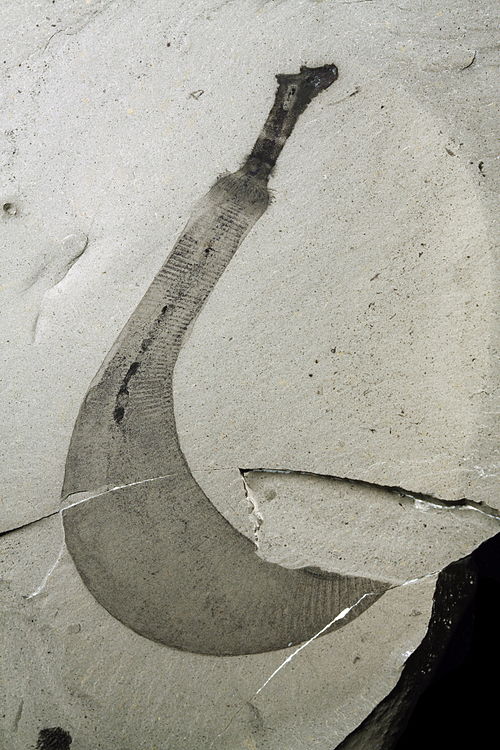Scalidophora is a group of marine pseudocoelomate ecdysozoans that was proposed on morphological grounds to unite three phyla: the Kinorhyncha, the Priapulida and the Loricifera.[8][9] The three phyla have four characters in common — chitinous cuticle that is moulted, rings of scalids on the introvert, flosculi, and two rings of introvert retracts.[10] The introvert and abdomen are separated by a distinct neck region in all groups, but in adult macroscopic priapulids it becomes rudimentary in Priapulus and is completely absent in Halicryptus.[11] However, the monophyly of the Scalidophora was not supported by two molecular studies, where the position of the Loricifera was uncertain[8] or as sister to the Panarthropoda.[9] Both studies supported a reduced Scalidophora comprising the Kinorhyncha and Priapulida as sister phyla. Their closest relatives are the Panarthropoda, Nematoda and Nematomorpha.
| Scalidophora | |||
|---|---|---|---|

| |||
| Ottoia prolifica from the Walcott Quarry of the Burgess Shale (Middle Cambrian) near Field, British Columbia, Canada. | |||
| Scientific classification | |||
| Kingdom: | Animalia | ||
| Subkingdom: | Eumetazoa | ||
| Clade: | ParaHoxozoa | ||
| Clade: | Bilateria | ||
| Clade: | Nephrozoa | ||
| Clade: | Protostomia | ||
| Superphylum: | Ecdysozoa | ||
| Clade: | Scalidophora Lemburg, 1995 | ||
| Phyla | |||
| |||
| Synonyms | |||
|
Cephalorhyncha, Priapozoa | |||
The two species in the genus Markuelia, known from fossilized embryos from the middle Cambrian, are thought to be stem scalidophorans.
The group has also been considered a single group, Cephalorhyncha,[12] with three classes.
The group is named after the spines (scalids) covering the introvert (head that can be retracted into the trunk).[13]
References
edit- ^ Harvey, T. H.; Dong, X.; Donoghue, P. C. (March–April 2010). "Are palaeoscolecids ancestral ecdysozoans?". Evolution & Development. 12 (2): 177–200. doi:10.1111/j.1525-142X.2010.00403.x. PMID 20433458. S2CID 16872271.
- ^ "A possible larval roundworm from the Cambrian 'Orsten' and its bearing on the phylogeny of Cycloneuralia".
- ^ Dong, X. -P.; Bengtson, S.; Gostling, N. J.; Cunningham, J. A.; Harvey, T. H. P.; Kouchinsky, A.; Val'Kov, A. K.; Repetski, J. E.; Stampanoni, M.; Marone, F.; Donoghue, P. C. J. (2010). "The anatomy, taphonomy, taxonomy and systematic affinity of Markuelia: Early Cambrian to Early Ordovician scalidophorans" (PDF). Palaeontology. 53 (6): 1291–1314. Bibcode:2010Palgy..53.1291D. doi:10.1111/j.1475-4983.2010.01006.x. S2CID 53483146.
- ^ a b Liu, Yunhuan; Qin, Jiachen; Wang, Qi; Maas, Andreas; Duan, Baichuan; Zhang, Yanan; Zhang, Hu; Shao, Tiequan; Zhang, Huaqiao (May 2019). "New armoured scalidophorans (Ecdysozoa, Cycloneuralia) from the Cambrian Fortunian Zhangjiagou Lagerstätte, South China". Papers in Palaeontology. 5 (2): 241–260. Bibcode:2019PPal....5..241L. doi:10.1002/spp2.1239.
- ^ Zhang, Hua-Qiao (September 2022). "The evolutionary relationships of the earliest known cycloneuralians and a new record from the Cambrian Fortunian of South China". Palaeoworld. 31 (3): 389–401. doi:10.1016/j.palwor.2021.09.003.
- ^ Shao, T.Q.; Qin, J.C.; Shao, Y.; Liu, Y.H.; Waloszek, D.; Maas, A.; Duan, B.C.; Wang, Q.; Xu, Y.; Zhang, H.Q. (October 2020). "New macrobenthic cycloneuralians from the Fortunian (lowermost Cambrian) of South China". Precambrian Research. 349 105413. Bibcode:2020PreR..34905413S. doi:10.1016/j.precamres.2019.105413.
- ^ Shao, T.Q.; Wang, Q.; Liu, Y.H.; Qin, J.C.; Zhang, Y.N.; Liu, M.J.; Shao, Y.; Zhao, J.Y.; Zhang, H.Q. (October 2020). "A new scalidophoran animal from the Cambrian Fortunian Stage of South China and its implications for the origin and early evolution of Kinorhyncha". Precambrian Research. 349 105616. Bibcode:2020PreR..34905616S. doi:10.1016/j.precamres.2020.105616.
- ^ a b Telford, M. J.; Bourlat, S. J.; Economou, A.; Papillon, D.; Rota-Stabelli, O. (27 April 2008). "The evolution of the Ecdysozoa". Philosophical Transactions of the Royal Society B. 363 (1496): 1529–1537. doi:10.1098/rstb.2007.2243. PMC 2614232. PMID 18192181.
- ^ a b Yamasaki, Hiroshi; Fujimoto, Shinta; Miyazaki, Katsumi (2015-06-30). "Phylogenetic position of Loricifera inferred from nearly complete 18S and 28S rRNA gene sequences". Zoological Letters. 1: 18. doi:10.1186/s40851-015-0017-0. ISSN 2056-306X. PMC 4657359. PMID 26605063.
- ^ Heiner, I., Kristensen, R.H. 2005. Two new species of the genus Pliciloricus (Loricifera, Pliciloricidae) from the Faroe Bank, North Atlantic. Zoologischer Anzeiger. 243: 121–138.
- ^ Multicellular Animals: Volume III: Order in Nature - System Made by Man, Volum 3
- ^ Dirnberger, J. "Explanations and Difficulties in Invertebrate Phylogeny". Invertebrate Zoology. Kennesaw State University. Retrieved 2012-08-11.
- ^ Dunn, C. W.; Hejnol, A.; Matus, D. Q.; Pang, K.; Browne, W. E.; Smith, S. A.; Seaver, E.; Rouse, G. W.; Obst, M.; et al. (10 April 2008). "Broad Phylogenomic Sampling Improves Resolution of the Animal Tree of Life". Nature. 452 (7188): 745–749. Bibcode:2008Natur.452..745D. doi:10.1038/nature06614. PMID 18322464. S2CID 4397099.